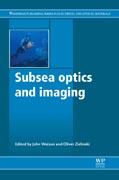
The use of optical methodology, instrumentation and photonics devices for imaging, vision and optical sensing is of increasing importance in understanding our marine environment. Subsea optics can make an important contribution to the protection and sustainable management of ocean resources and contribute to monitoring the response of marine systems to climate change. This important book provides an authoritative review of key principles, technologies and their applications.The book is divided into three parts. The first part provides a general introduction to the key concepts in subsea optics and imaging, imaging technologies and the development of ocean optics and colour analysis. Part two reviews the use of subsea optics in environmental analysis. An introduction to the concepts of underwater light fields is followed by an overview of coloured dissolved organic matter (CDOM) and an assessment of nutrients in the water column. This section concludes with discussions of the properties of subsea bioluminescence, harmful algal blooms and their impact and finally an outline of optical techniques for studying suspended sediments, turbulence and mixing in the marine environment. Part three reviews subsea optical systems technologies. A general overview of imaging and visualisation using conventional photography and video leads onto advanced techniques like digital holography, laser line-scanning and range-gated imaging as well as their use in controlled observation platforms or global observation networks. This section also outlines techniques like Raman spectroscopy, hyperspectral sensing and imaging, laser Doppler anemometry (LDA) and particle image velocimetry (PIV), optical fibre sensing and LIDAR systems. Finally, a chapter on fluorescence methodologies brings the volume to a close.With its distinguished editor and international team of contributors, Subsea optics and imaging is a standard reference for those researching, developing and using subsea optical technologies as well as environmental scientists and agencies concerned with monitoring the marine environment. Provides an authoritative review of key principles, technologies and their applicationsOutlines the key concepts in subsea optics and imaging, imaging technologies and the development of ocean optics and colour analysisReviews the properties of subsea bioluminescence, harmful algal blooms and their impact INDICE: Part 1 Introduction and historic review of subsea optics and imaging: Subsea optics: An introduction; Subsea imaging and vision: An introduction; The history of subsea optics. Part 2 Biogeochemical optics in the environment: Measurement of hyperspectral underwater light fields; Colored dissolved organic matter in seawater; Optical assessment of nutrients in seawater; Bioluminescence in the sea; Optical assessment of harmful algal blooms (HAB); Optical techniques in studying suspended sediment, turbulence and mixing in marine environments. Part 3 Subsea optical systems and imaging: Geometric optics and strategies for subsea imaging; Underwater imaging: Photographic, digital and video techniques; Subsea holography and submersible holocameras?; Subsea laser scanning and imaging systems; Laser doppler anemometry (LDA) and particle image velocimetry (PIV) for marine environments; Underwater 3D vision, ranging and range gating; Raman spectroscopy for subsea applications; Fibre optic sensors for subsea structural health monitoring; Subsea lidar systems; Operational multiparameter subsea observation platforms; Underwater hyperspectral imagery to create biogeochemical maps of seafloor properties; Advances in underwater fluorometry: From bulk fluorescence to planar laser imaging.
- ISBN: 978-0-85709-341-7
- Editorial: Woodhead Publishing
- Encuadernacion: Cartoné
- Páginas: 608
- Fecha Publicación: 08/10/2013
- Nº Volúmenes: 1
- Idioma: Inglés
